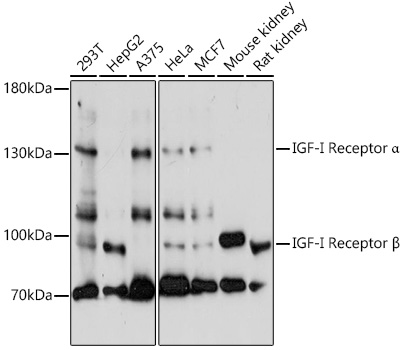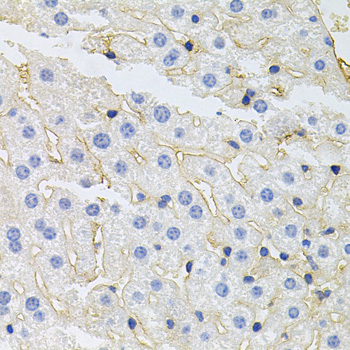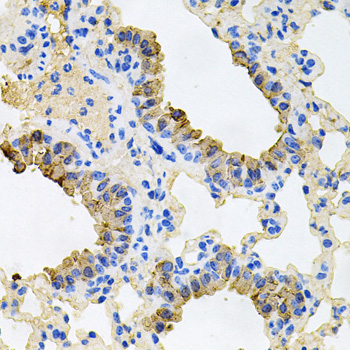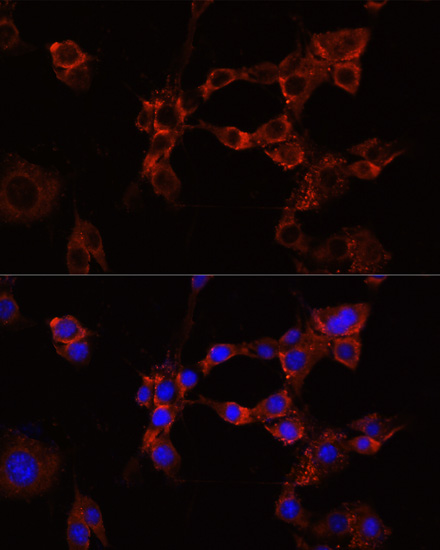Anti-IGF1R Antibody (CAB0243)
- SKU:
- CAB0243
- Product type:
- Antibody
- Reactivity:
- Human
- Reactivity:
- Mouse
- Reactivity:
- Rat
- Host Species:
- Rabbit
- Isotype:
- IgG
- Antibody Type:
- Polyclonal Antibody
- Research Area:
- Cell Biology
Description
| 抗体名: | Anti-IGF1R Antibody |
| 抗体コード: | CAB0243 |
| 抗体サイズ: | 20uL, 50uL, 100uL |
| 申し込み: | WB IHC IF |
| 反応性: | Human, Mouse, Rat |
| 宿主種: | Rabbit |
| 免疫原: | A synthetic peptide corresponding to a sequence within amino acids 660-760 of human IGF1R (NP_000866.1). |
| 申し込み: | WB IHC IF |
| 推奨希釈: | WB 1:500 - 1:2000 IHC 1:50 - 1:200 IF 1:50 - 1:200 |
| 反応性: | Human, Mouse, Rat |
| ポジティブサンプル: | 293T, HepG2, A375, HeLa, MCF7, Mouse kidney, Rat kidney |
| 免疫原: | A synthetic peptide corresponding to a sequence within amino acids 660-760 of human IGF1R (NP_000866.1). |
| 精製方法: | Affinity purification |
| ストレージバッファ: | Store at -20'C. Avoid freeze / thaw cycles. Buffer: PBS with 0.02% sodium azide, 50% glycerol, pH7.3. |
| アイソタイプ: | IgG |
| 順序: | HNYC SKDK IPIR KYAD GTID IEEV TENP KTEV CGGE KGPC CACP KTEA EKQA EKEE AEYR KVFE NFLH NSIF VPRP ERKR RDVM QVAN TTMS SRSR NTTA A |
| 遺伝子ID: | 3480 |
| Uniprot: | P08069 |
| セルラーロケーション: | Cell membrane, Single-pass type I membrane protein |
| 計算された分子量: | 154kDa |
| 観察された分子量: | 90kDa/130kDa |
| 同義語: | IGF1R, CD221, IGFIR, IGFR, JTK13 |
| バックグラウンド: | This receptor binds insulin-like growth factor with a high affinity. It has tyrosine kinase activity. The insulin-like growth factor I receptor plays a critical role in transformation events. Cleavage of the precursor generates alpha and beta subunits. It is highly overexpressed in most malignant tissues where it functions as an anti-apoptotic agent by enhancing cell survival. Alternatively spliced transcript variants encoding distinct isoforms have been found for this gene. |
| UniProt Protein Function: | IGF1R: a receptor tyrosine kinase that binds insulin-like growth factor 1 (IGF1) with a high affinity and IGF2 with a lower affinity. Functions as an anti-apoptotic agent by enhancing cell survival. Can play a critical role in transformation events. Cleavage of the precursor generates alpha and beta subunits. Tetramer of 2 alpha and 2 beta chains linked by disulfide bonds. The alpha chains contribute to the formation of the ligand- binding domain, while the beta chain carries the kinase domain. Interacts with PIK3R1 and with the PTB/PID domains of IRS1 and SHC1 in vitro when autophosphorylated on tyrosine residues. Mutated in rare cases of pre- and post-natal growth retardation. One SNP associated with increased human longevity. Increased expression of IGF1R and other pathway members associated with progression and malignancy in a range of cancers. Inhibitors: AG1024, AEW541. |
| UniProt Protein Details: | Protein type:Protein kinase, tyrosine (receptor); Protein kinase, TK; Kinase, protein; Membrane protein, integral; EC 2.7.10.1; TK group; InsR family Chromosomal Location of Human Ortholog: 15q26.3 Cellular Component: integral to plasma membrane; intracellular membrane-bound organelle; membrane; plasma membrane; receptor complex Molecular Function:ATP binding; identical protein binding; insulin binding; insulin receptor binding; insulin receptor substrate binding; insulin-like growth factor binding; insulin-like growth factor I binding; insulin-like growth factor receptor activity; phosphoinositide 3-kinase binding; protein binding; protein-tyrosine kinase activity Biological Process: brain development; epidermis development; exocrine pancreas development; immune response; inactivation of MAPKK activity; insulin receptor signaling pathway; insulin-like growth factor receptor signaling pathway; male sex determination; mammary gland development; negative regulation of apoptosis; negative regulation of protein kinase B signaling cascade; negative regulation of transcription factor activity; phosphoinositide 3-kinase cascade; phosphoinositide-mediated signaling; positive regulation of cell migration; positive regulation of cell proliferation; positive regulation of DNA replication; positive regulation of MAPKKK cascade; positive regulation of mitosis; positive regulation of protein kinase B signaling cascade; protein amino acid autophosphorylation; protein tetramerization; regulation of JNK cascade; signal transduction Disease: Insulin-like Growth Factor I, Resistance To |
| NCBI Summary: | This receptor binds insulin-like growth factor with a high affinity. It has tyrosine kinase activity. The insulin-like growth factor I receptor plays a critical role in transformation events. Cleavage of the precursor generates alpha and beta subunits. It is highly overexpressed in most malignant tissues where it functions as an anti-apoptotic agent by enhancing cell survival. Alternatively spliced transcript variants encoding distinct isoforms have been found for this gene. [provided by RefSeq, May 2014] |
| UniProt Code: | P08069 |
| NCBI GenInfo Identifier: | 124240 |
| NCBI Gene ID: | 3480 |
| NCBI Accession: | P08069.1 |
| UniProt Secondary Accession: | P08069,Q14CV2, Q9UCC0, B1B5Y2, |
| UniProt Related Accession: | P08069 |
| Molecular Weight: | |
| NCBI Full Name: | Insulin-like growth factor 1 receptor |
| NCBI Synonym Full Names: | insulin like growth factor 1 receptor |
| NCBI Official Symbol: | IGF1R |
| NCBI Official Synonym Symbols: | IGFR; CD221; IGFIR; JTK13 |
| NCBI Protein Information: | insulin-like growth factor 1 receptor |
| UniProt Protein Name: | Insulin-like growth factor 1 receptor |
| UniProt Synonym Protein Names: | Insulin-like growth factor I receptor; IGF-I receptor |
| Protein Family: | Insulin-like growth factor 1 receptor |
| UniProt Gene Name: | IGF1R |
| UniProt Entry Name: | IGF1R_HUMAN |





